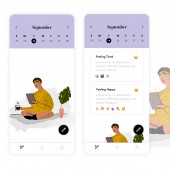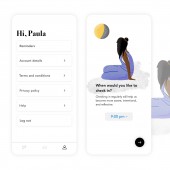Joyster App Mobile App by Paula Barcante |
Home > Winners > #104051 |
 |
|
||||
| DESIGN DETAILS | |||||
| DESIGN NAME: Joyster App PRIMARY FUNCTION: Mobile App INSPIRATION: One out of four people experience mental health in today’s society. Last year, Paula experienced ten days of panic attacks out of the blue. The mental symptoms were terrible and the physical symptoms were worse. She was frustrated by the fact that no one could tell her why this was happening or how she could prevent it. Paula started my own spreadsheet to track her physical body symptoms and mental symptoms against what she was doing, who she was seeing, and what she was eating to understand what helped and what did not. After twenty spreadsheets Paula decided to create Joyster. UNIQUE PROPERTIES / PROJECT DESCRIPTION: Joyster is an app that allows users to understand their overall health by tracking their mental symptoms against their physical well-being and daily activities. Journaling every night or remembering what happened during the day can be time consuming, which is where Joyster comes in. The process of adding an entry takes less than thirty seconds. The app analyzes all data it has and outputs activities, foods, and personalized content that are making a positive or negative impact on one’s well-being. OPERATION / FLOW / INTERACTION: The app is extremely simple and leverages existing technological behavior seen in popular apps. It is attractive, clean, and delightful. The daily entires are a simple list of symptoms and activities that users can tap on to select and create their own. Every day of the week the user sees a new illustration on their dashboard to create delight and inspiration for adopting a healthy lifestyle. The insights are straightforward and effective in showing trends and triggers. Additionally, Joyster sends insights based on an individual's weekly improvements. PROJECT DURATION AND LOCATION: The project is still going. The project is currently taking place in Vancouver Island, Canada. |
PRODUCTION / REALIZATION TECHNOLOGY: Joyster began with the user. Paula completed two rounds of research, one interview based and a purely functional test. Additionally, therapists user tested the app to provide valuable feedback. For the design Paula used Sketch, InVision, and Procreate. SPECIFICATIONS / TECHNICAL PROPERTIES: Paula designed the entire end-to-end experience for iOS and Android. This included the information architecture, persona development, UX Research, UX design, visuals, illustrations, and design system. TAGS: UI Design, mobile app, Product Design, Health, Mental Health, UX Design, iOS, Android, Illustration RESEARCH ABSTRACT: Paula ran two types of research. The first one was eight user interviews. The purpose of this research was to understand the market and overall interest in Joyster. The script consisted of open ended questions focusing on how users currently keep track of their symptoms, feelings, what they do to understand themselves better, and their overall interest. The second research was a usability test. The purpose of this test was completely functional, to understand how easy or difficult it was to navigate through the app. CHALLENGE: The main challenge was the ability to create an app like this that felt effortless for the user. Additionally, the ability add a scale for each symptom was a challenge as symptoms can be physical or mental. ADDED DATE: 2020-03-22 20:00:09 TEAM MEMBERS (1) : Paula Barcante IMAGE CREDITS: Image #1: Designer Paula Barcante, 2020 Optional Image #2: Designer/Illustrator/Creator Paula Barcante, 2020 Optional Image #3: Designer/Illustrator/Creator Paula Barcante, 2020 Optional Image #4: Designer/Illustrator/Creator Paula Barcante, 2020 Optional Image #5: Designer/Illustrator/Creator Paula Barcante, 2020 |
||||
| Visit the following page to learn more: https://joyster.app | |||||
| AWARD DETAILS | |
 |
Joyster App Mobile App by Paula Barcante is Winner in Mobile Technologies, Applications and Software Design Category, 2019 - 2020.· Press Members: Login or Register to request an exclusive interview with Paula Barcante. · Click here to register inorder to view the profile and other works by Paula Barcante. |
| SOCIAL |
| + Add to Likes / Favorites | Send to My Email | Comment | Testimonials | View Press-Release | Press Kit |







